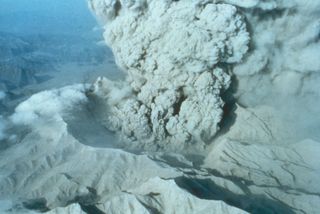Volcanoes Cooled Earth Less Than Thought

Global cooling caused by some historic volcanic eruptions wasn't as extreme as climate scientists recently thought, according to newly revised ice core records from Antarctica.
Volcanic eruptions blast sulfur-dioxide gas into the stratosphere, where it turns into tiny particles called sulfate aerosols that reflect the sun's energy and cool the Earth. Snow falling in Antarctica records the levels of sulfate in the air at the time, and it eventually becomes ice drilled by researchers in long, tubular cores.
Researchers have measured sulfate concentrations in 26 ice cores from 19 different locations in Antarctica that cover the last 2,000 years of Earth's history — the best record yet, the researchers said. The team synchronized the sulfate records with ice cores from Greenland, to determine if the eruptions had a truly global effect.
Along with finding previously unknown volcanic eruptions in the ice cores from before A.D. 500, the researchers discovered that some historic eruptions weren't as hard on the planet as earlier climate models suggested. [The 10 Biggest Volcanic Eruptions in History]
Sorting out these signals helps improve climate models, said Michael Sigl, a climate scientist at the Desert Research Institute in Reno, Nevada, and lead author of the study, published July 6 in the journal Nature Climate Change.
The team identified 116 volcanic eruptions in the ice cores from the nearly 20 sites covering the past 2,000 years, including historic events such as Tambora in 1815, Kuwae in 1458 and Samalas (or Mount Rinjani) in 1257. Not all of these 116 eruptions are recorded in Greenland's ice cores, but for their next project, the researchers are planning to assess sulfate levels in the Greenland cores.
"I think there will be more tropical eruptions there than we can detect at the moment," Sigl said.
Sign up for the Live Science daily newsletter now
Get the world’s most fascinating discoveries delivered straight to your inbox.
Tropical volcanoes, such as those in Indonesia and Central America, are ideally positioned to cool the planet by spreading sulfates across both hemispheres, compared with volcanoes at high latitudes, he said.
The new ice-core record reveals that the 13th century was marked by an onslaught of tropical eruptions, such as the massive 1257 eruption of Mount Rinjani. Some researchers think these eruptions triggered the start of the Little Ice Age, an episode of global cooling that lasted until the 1850s.
It turns out that Indonesia's Kuwae and Samalas — two of the largest tropical volcanic eruptions in the ice core record — deposited 30 to 35 percent less sulfate in Antarctica than previously had been calculated. The new ice core records are more detailed than before, and cover a greater area of Antarctica, so the researchers can better estimate how much sulfate was deposited across the continent. The new results suggest that these two eruptions had a weaker cooling effect on global climate than once thought, the researchers said.
"The ice cores provide a picture of the sulfate levels you could expect in the stratosphere," Sigl said. "It looks like the sulfate levels that had been predicted previously overestimated the strength of the eruptions."
The correlation between ice cores in Antarctica and those in Greenland also led the researchers to revise the eruption dates for some of the better-known blasts.
Here are possible candidates for the 10 biggest eruptions found in the ice cores, based on levels of sulfates, from biggest to smallest:
- Samalas, Indonesia – 1257
- Kuwae, Vanuatu – 1458
- Tambora, Indonesia – 1815
- Mount Churchill, Alaska – 674
- Rabaul Caldera, Papua New Guinea – (listed for two eruptions) 531 and 566
- Quilotoa, Andes – 1280
- Ilopango, Central America – 450
- Laki, Iceland – 1785
- Mount Rinjani, Indonesia – Between 1200 and 1250
Email Becky Oskin or follow her @beckyoskin. Follow us @livescience, Facebook & Google+. Original article on Live Science.

Most Popular



